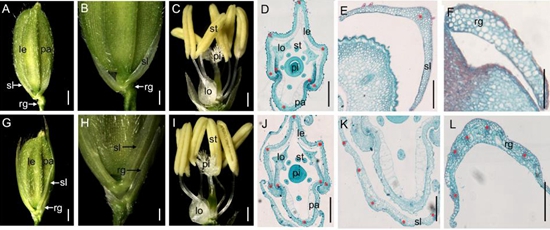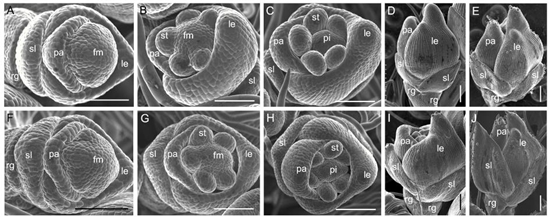分享到
Regulatory Role of OsMADS34 in the Determination of Glumes Fate, Grain Yield, and Quality in Rice
In most flowering plants, flowers consist of sepals, petals, stamens, and pistils, which are arranged in concentric whorls. Genetic and morphological studies of floral homeotic mutants in eudicots have established the classical ABC model of floral development, and subsequently the ABCDE model, which can also partly explain floral development in grass species. As a model monocot plant, rice has unique floral architecture that differs from eudicots. The spikelet is the floral unit in rice and comprises one floret and two pairs of glume-like organs, rudimentary glumes and sterile lemmas (glumes). The genetic mechanisms that control spikelet development in rice remain poorly understood.
Recently, researchers from China National Rice Research Institute (CNRRI) , Zhejiang Normal University and Hangzhou Normal University examined OsMADS34 function in determining the identities of glumes (rudimentary glume and sterile lemma) and grain size through the m34-z mutant, a new mutant allele of the rice (Oryza sativa) E-class gene OsMADS34. The results revealed that both the rudimentary glume and sterile lemma in the mutant were homeotically converted to the lemma-like organ and acquired the lemma identity, suggesting that OsMADS34 plays important roles in the development of glumes, most of the grains from the secondary panicle branches (spb) in the mutant were decreased in size, compared with grains from wild-type, but no differences were observed in the grains from the primary panicle branches. The amylose content and gel consistency, and a seed-setting rate from the spb were reduced in the m34-z mutant. Interestingly, transcriptional activity analysis revealed that OsMADS34 protein was a transcription repressor and it may influence grain yield by suppressing the expressions of BG1, GW8, GW2, and GL7 which were involved in grain size in the m34-z mutant. These findings revealed that OsMADS34 largely affects grain yield by affecting the size of grains from the secondary branches.
This work was supported by the National Natural Science Foundation of China (31401464, 31461143014, and 31521064) and the National Science and Technology Major Project (2016ZX08009003-003-008), Zhejiang Provincial Natural Science Foundation of China (LY16C130001). The research finding has been published in Frontiers in Plant Science online on December 15, 2016 (DOI: https://doi.org/10.3389/fpls.2016.01853).
More details are available on the links bellow:
http://journal.frontiersin.org/article/10.3389/fpls.2016.01853/full?&
Recently, researchers from China National Rice Research Institute (CNRRI) , Zhejiang Normal University and Hangzhou Normal University examined OsMADS34 function in determining the identities of glumes (rudimentary glume and sterile lemma) and grain size through the m34-z mutant, a new mutant allele of the rice (Oryza sativa) E-class gene OsMADS34. The results revealed that both the rudimentary glume and sterile lemma in the mutant were homeotically converted to the lemma-like organ and acquired the lemma identity, suggesting that OsMADS34 plays important roles in the development of glumes, most of the grains from the secondary panicle branches (spb) in the mutant were decreased in size, compared with grains from wild-type, but no differences were observed in the grains from the primary panicle branches. The amylose content and gel consistency, and a seed-setting rate from the spb were reduced in the m34-z mutant. Interestingly, transcriptional activity analysis revealed that OsMADS34 protein was a transcription repressor and it may influence grain yield by suppressing the expressions of BG1, GW8, GW2, and GL7 which were involved in grain size in the m34-z mutant. These findings revealed that OsMADS34 largely affects grain yield by affecting the size of grains from the secondary branches.
This work was supported by the National Natural Science Foundation of China (31401464, 31461143014, and 31521064) and the National Science and Technology Major Project (2016ZX08009003-003-008), Zhejiang Provincial Natural Science Foundation of China (LY16C130001). The research finding has been published in Frontiers in Plant Science online on December 15, 2016 (DOI: https://doi.org/10.3389/fpls.2016.01853).
More details are available on the links bellow:
http://journal.frontiersin.org/article/10.3389/fpls.2016.01853/full?&


Latest News
-
 Apr 18, 2024Opening Ceremony of the Training Workshop on Wheat Head Scab Resistance Breeding and Pest Control in Africa Held in CAAS
Apr 18, 2024Opening Ceremony of the Training Workshop on Wheat Head Scab Resistance Breeding and Pest Control in Africa Held in CAAS -
 Apr 03, 2024IPPCAAS Co-organized the Training Workshop on Management and Application of Biopesticides in Nepal
Apr 03, 2024IPPCAAS Co-organized the Training Workshop on Management and Application of Biopesticides in Nepal -
 Mar 28, 2024Delegation from the School of Agriculture and Food Science of University College Dublin, Ireland Visit to IAS, CAAS
Mar 28, 2024Delegation from the School of Agriculture and Food Science of University College Dublin, Ireland Visit to IAS, CAAS -
 Mar 25, 2024Director of World Food Prize Foundation visited GSCAAS
Mar 25, 2024Director of World Food Prize Foundation visited GSCAAS -
 Mar 20, 2024Institute of Crop Sciences (ICS) and Syngenta Group Global Seeds Advance Collaborative Research in the Seed Industry
Mar 20, 2024Institute of Crop Sciences (ICS) and Syngenta Group Global Seeds Advance Collaborative Research in the Seed Industry
